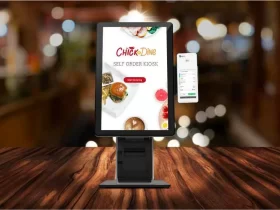In the fast-paced world of the restaurant industry, where efficiency and customer satisfaction are paramount, the rise of touch screen self-service kiosks has revolutionized the way businesses operate. For restaurant owners, embracing this technology is not just a trend but a strategic move to enhance the dining experience, streamline operations, and boost profitability. The demand for self-service kiosks, especially in the realm of self-ordering for restaurants, has surged, signaling a shift towards more automated, user-friendly service models.
This blog will delve into why touch screen self-service kiosks have become an indispensable part of the modern restaurant landscape, exploring the multifaceted benefits they offer and how they can be a game-changer for your business.
The Rise of Touch Screen Self-Service Kiosks in the Restaurant Industry
In recent years, the restaurant sector has witnessed a significant transformation, with touch screen self-service kiosks becoming increasingly prevalent. These kiosks, ranging from self-ordering to payment and feedback systems, have become a staple in fast-food chains, casual dining restaurants, and even high-end eateries. But what is driving this surge in popularity?
Must Read: How to Implement a Restaurant Kiosk in Your Store?
Enhancing Customer Experience
One of the primary reasons for the rising demand for self-service kiosks is the enhanced customer experience they offer. Customers enjoy the control and convenience of browsing the menu, customizing orders, and making payments at their own pace without feeling rushed or waiting in long queues. This not only improves the overall dining experience but also caters to the growing consumer preference for quick, seamless, and personalized service.
Operational Efficiency and Cost Savings
For restaurant owners, the appeal of self-service kiosks lies in their ability to streamline operations and reduce labor costs. By automating the ordering process, these kiosks can handle a high volume of orders with precision, reducing human error and freeing up staff to focus on food preparation and customer service. This operational efficiency translates into faster service times, increased table turnover, and ultimately, higher revenue.
Leveraging Data for Business Insights
Self-service kiosks are not just order-taking devices; they are also powerful data collection tools. By integrating kiosk software and systems, restaurant owners can track customer preferences, order patterns, and peak dining times. This data is invaluable for making informed decisions about menu adjustments, pricing strategies, and promotional offers, ensuring that the restaurant stays competitive and responsive to market trends.
Meeting the Demand for Contactless Transactions
The COVID-19 pandemic has accelerated the demand for contactless dining options, with customers prioritizing safety and hygiene. Self-service kiosks offer a contactless ordering and payment solution, reducing physical interactions between staff and customers. This not only helps in adhering to health and safety guidelines but also builds customer trust and confidence in the restaurant’s commitment to their well-being.
Must Read: Are Self-Serve Kiosks the Key to Boosting Your Restaurant’s Revenue?
Customization and Branding Opportunities
Self-service kiosks provide an excellent platform for restaurants to showcase their brand and engage with customers in a unique way. The customizable interfaces of these kiosks can be tailored to reflect the restaurant’s theme, promotions, and special offers, creating a memorable and immersive ordering experience. Additionally, the flexibility to update and modify the digital menu in real-time allows restaurants to respond quickly to market trends and customer feedback.
Conclusion
The integration of touch screen self-service kiosks in the restaurant industry is more than a technological upgrade; it’s a strategic evolution that aligns with changing consumer behaviors and market demands. For restaurant owners, investing in self-service kiosk technology is not just about staying current; it’s about enhancing the customer experience, optimizing operations, and securing a competitive edge in a dynamic industry. As we move forward, the role of self-service kiosks in shaping the future of dining is undeniable, making them an essential component of the modern restaurant experience. Embracing this technology can lead to increased efficiency, customer satisfaction, and ultimately, business success.












Leave a Reply